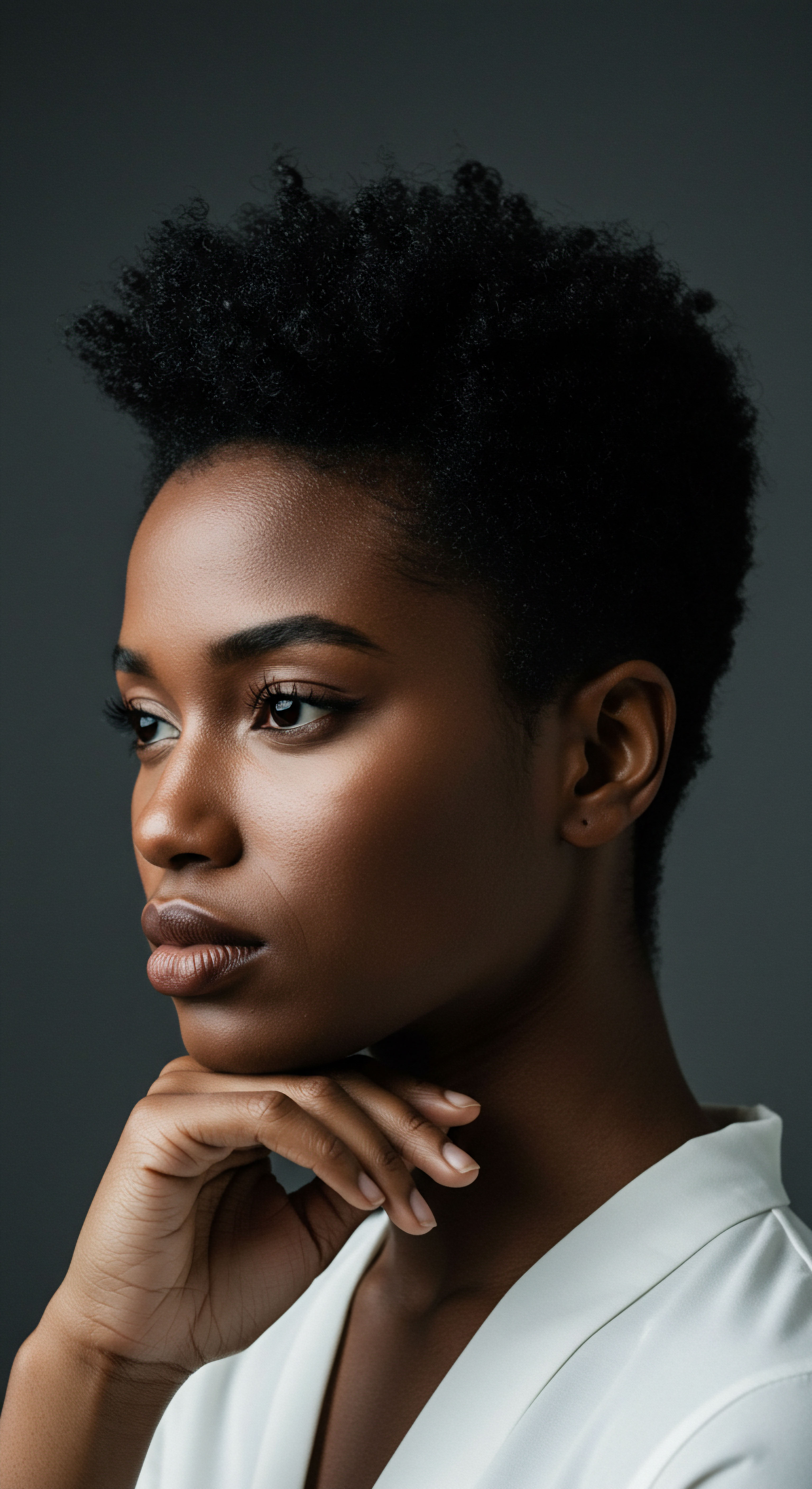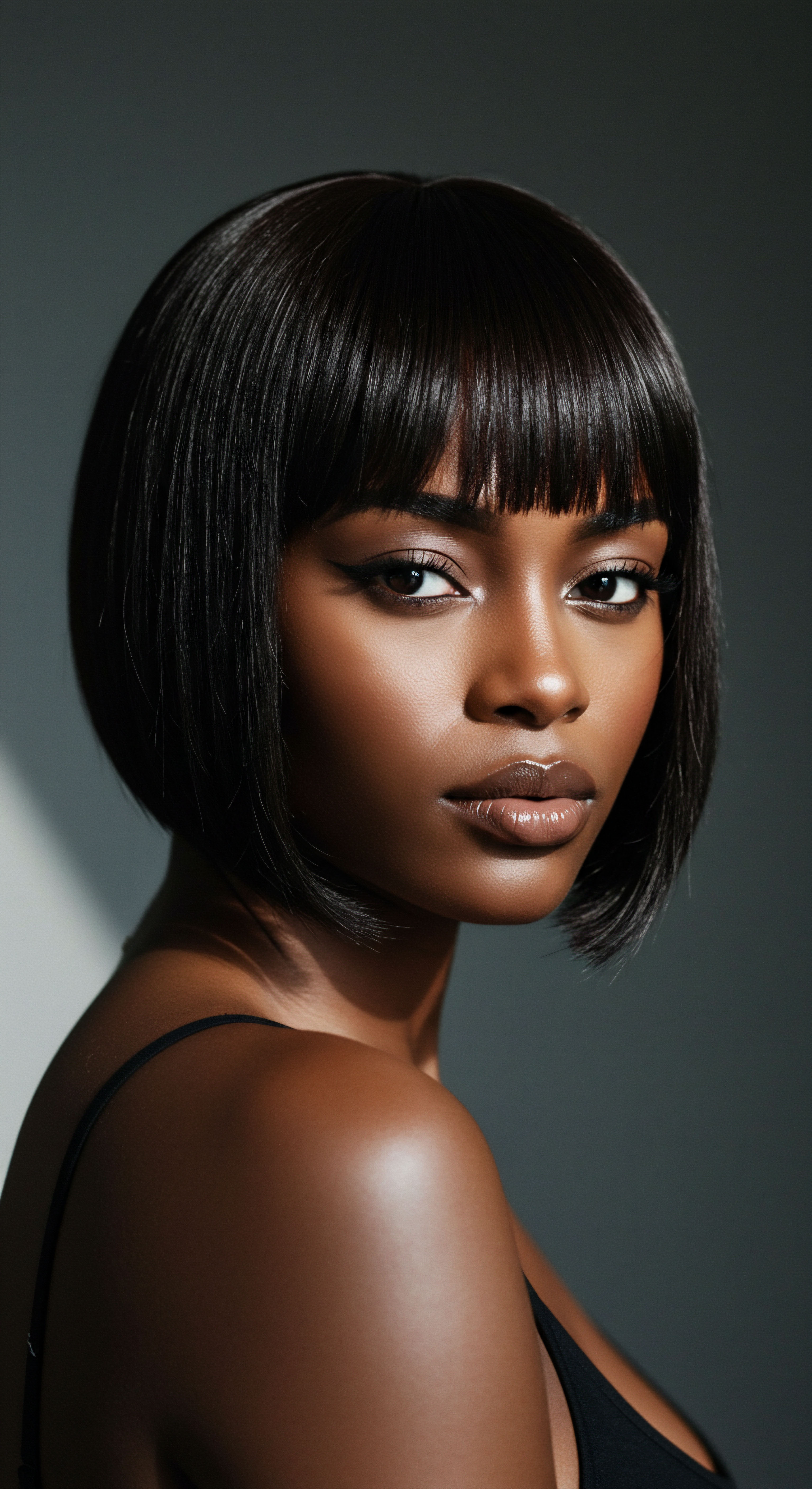
Roots
There exists a quiet hum beneath the surface of our daily lives, a rhythm deeply connected to the very strands that crown us. We often consider our hair a separate entity, a canvas for expression or a testament to genetics, yet it whispers stories of our internal balance. The quest for vibrant, thriving textured hair frequently leads us down paths of external application and intricate styling, overlooking the profound internal symphonies that orchestrate its very being. To truly understand how our hair flourishes, we must journey inward, to the unseen processes that nourish its beginnings, specifically the delicate dance of scalp circulation and the profound impact of consistent sleep.
Our hair, whether tightly coiled, loosely waved, or beautifully braided, begins its existence within the scalp, a living landscape teeming with activity. Each strand emerges from a hair follicle, a miniature organ embedded within the dermis. These follicles are not isolated structures; they are deeply intertwined with a complex network of blood vessels that serve as their lifeblood.
This intricate vascular system delivers the essential nutrients, oxygen, and hormones required for cellular proliferation and healthy hair fiber formation. Without a robust and uninterrupted supply, the hair follicle struggles, much like a plant deprived of water and sunlight.
The health of our hair begins beneath the surface, sustained by the vital flow of blood to each follicle.

The Scalp’s Microcirculatory System
The scalp’s circulatory system is a marvel of biological engineering. It consists of arterioles, capillaries, and venules, all working in concert to ensure a steady exchange of substances. The capillaries, microscopic vessels, are where the true magic happens. Here, oxygen and nutrients pass from the blood into the surrounding tissues, including the dermal papilla—a small, cone-shaped structure at the base of the hair follicle that houses the capillaries and provides the necessary nourishment for hair growth.
Simultaneously, metabolic waste products are carried away, maintaining a pristine environment for cellular activity. A well-functioning microcirculation ensures that the hair follicle receives a continuous supply of building blocks, allowing it to produce strong, resilient hair fibers.
Consider the scalp not merely as skin, but as a fertile ground. Just as a gardener tends to the soil, ensuring it is rich and aerated for optimal plant growth, our bodies inherently work to maintain the vitality of our scalp. Disruptions to this delicate system, whether from external pressures or internal imbalances, can directly affect the hair growth cycle. The intricate dance of blood flow, oxygen delivery, and nutrient uptake is a fundamental pillar upon which hair health rests.

Hair Growth Cycle and Its Interconnectedness
Hair growth is not a continuous, linear process. It unfolds in distinct phases ❉ Anagen (growth), Catagen (transition), and Telogen (resting). The anagen phase, where hair actively grows, is highly dependent on consistent nutrient and oxygen supply from scalp circulation. Any compromise to this supply can shorten the anagen phase, leading to thinner, weaker strands or even premature shedding.
- Anagen Phase ❉ This active growth period can span several years. During this time, cells in the hair matrix rapidly divide, pushing the hair shaft upwards. Robust scalp circulation is paramount for sustaining this high metabolic activity.
- Catagen Phase ❉ A brief transitional phase, lasting a few weeks, where the hair follicle shrinks and detaches from the dermal papilla.
- Telogen Phase ❉ The resting phase, typically lasting a few months, after which the old hair sheds, and a new anagen hair begins to grow.
The synchronization of these cycles across the scalp is also influenced by various internal factors, including hormonal balance and overall physiological well-being. A disruption in one area, such as consistent sleep patterns, can ripple through the entire system, impacting the very rhythm of hair growth. Understanding this foundational biology allows us to appreciate the subtle yet profound connections between our daily habits and the health of our hair.

Ritual
The whisper of the night, often perceived as a mere pause between days, holds a quiet power for renewal. For textured hair, the hours of slumber are not simply moments of rest; they are a vital period of restoration, where the body, in its wisdom, orchestrates processes that directly influence the vibrancy of our strands. The practical wisdom we seek for hair health often resides in the seemingly simple, consistent rhythms of our lives. When we consider how sleep routines influence scalp circulation, we are looking at an applied science, a daily practice that can profoundly reshape the health of our hair from its very roots.
During sleep, our bodies engage in crucial repair and regeneration. This includes the delicate network of blood vessels supplying the scalp. A consistent sleep routine—meaning going to bed and waking up around the same time each day—helps to regulate our circadian rhythm, the body’s internal clock.
This rhythm influences numerous physiological processes, including blood flow, hormone secretion, and cellular repair. When our sleep patterns are erratic, this natural rhythm is disrupted, potentially leading to suboptimal conditions for scalp circulation and, by extension, hair growth.

How Does Sleep Consistency Impact Scalp Circulation?
The connection between consistent sleep and robust scalp circulation is multi-layered. During periods of deep, restorative sleep, the body’s metabolic rate slows, allowing energy to be redirected towards repair and maintenance. This includes the dilation of blood vessels, which can improve blood flow to peripheral areas like the scalp.
Furthermore, consistent sleep supports the healthy secretion of various hormones critical for hair growth. Growth Hormone, for example, is predominantly released during deep sleep stages. This hormone plays a significant part in cellular regeneration and tissue repair, which directly benefits hair follicle activity. Without adequate, consistent sleep, the release of this essential hormone can be compromised, potentially hindering the hair’s ability to regenerate and grow.
| Hormone Growth Hormone |
| Primary Function During Sleep Peak secretion during deep sleep; cellular repair |
| Impact on Hair Health Stimulates hair matrix cell proliferation, promoting anagen phase |
| Hormone Melatonin |
| Primary Function During Sleep Regulates sleep-wake cycle; antioxidant properties |
| Impact on Hair Health May directly influence hair follicle activity and protect cells from oxidative stress |
| Hormone Cortisol |
| Primary Function During Sleep Stress hormone; levels naturally lower during sleep |
| Impact on Hair Health Elevated levels due to poor sleep can contribute to hair shedding |
| Hormone Consistent sleep helps balance these hormones, creating a conducive environment for hair growth. |

Can Specific Nighttime Rituals Bolster Scalp Health?
Beyond simply sleeping, the rituals we adopt before slumber can further enhance the benefits for scalp circulation. Gentle scalp massages, for instance, can physically stimulate blood flow to the area. Incorporating a few minutes of mindful massage with fingertips, perhaps using a light, nourishing oil suitable for textured hair, can become a soothing prelude to sleep. This gentle action can help to dilate superficial blood vessels, encouraging a more vigorous supply of nutrients to the follicles.
Nightly rituals, like gentle scalp massage, can enhance blood flow and nutrient delivery to hair follicles.
The choice of nighttime hair protection also plays a subtle yet significant part. Wearing a satin or silk bonnet or sleeping on a satin pillowcase minimizes friction on the hair and scalp. While this primarily safeguards the hair strand from breakage, it also contributes to a more undisturbed scalp environment, allowing the circulatory system to operate without external irritation. A serene scalp is better poised to receive the benefits of the body’s nocturnal repair processes.
A study published in the Clinical and Experimental Dermatology in 2022, led by Dubois, explored melatonin’s dual role. The research indicated that while melatonin is well-known for regulating sleep, it also exhibits direct vasodilatory effects on microvessels in the scalp, potentially increasing blood flow and acting as a powerful antioxidant for hair follicle cells. This suggests that the body’s natural melatonin production during proper sleep cycles directly contributes to an environment conducive to hair health beyond merely providing rest. This deeper understanding underscores the importance of honoring our sleep cycles, allowing these intricate biological mechanisms to unfold without impediment.

Relay
How do the unseen currents of our sleep, the very cadence of our rest, translate into the visible vitality of our textured strands? This question leads us into a more profound conversation, one that connects the intricate biological mechanisms of sleep with the cultural and personal narratives of hair care. It is a dialogue that transcends simple cause and effect, inviting us to consider the systemic interplay of factors that shape not just our physical being, but our very perception of well-being and beauty. The true depth of understanding lies in recognizing how our consistent sleep patterns act as a conduit, relaying signals throughout the body that ultimately arrive at the scalp, influencing its capacity for vibrant hair growth.
The notion of “consistent sleep routines” moves beyond mere hours logged in bed. It speaks to a synchronized internal environment, where the body’s physiological systems operate in a harmonious rhythm. When this rhythm is disrupted, the consequences ripple through multiple biological pathways, many of which directly or indirectly influence scalp health and hair growth.
Chronic sleep disruption, for instance, can elevate levels of stress hormones like cortisol, which, over prolonged periods, can constrict blood vessels, including those supplying the scalp. This constriction can reduce the delivery of oxygen and nutrients, creating a less than ideal environment for hair follicles.

The Neuroendocrine Connection to Hair Vitality
The brain and the endocrine system are deeply interconnected with sleep. The quality and consistency of our sleep directly influence the secretion of various hormones that regulate cellular growth and repair. Beyond growth hormone, which we know peaks during deep sleep, other neuroendocrine signals are also at play. For instance, the hypothalamic-pituitary-adrenal (HPA) axis, our central stress response system, is modulated by sleep.
Chronic sleep deprivation can lead to HPA axis dysregulation, resulting in sustained elevated cortisol levels. These elevated levels have been associated with increased oxidative stress and inflammation, which can directly impact the health of the hair follicle and its surrounding microenvironment.
Consider the cellular machinery within each hair follicle. These cells are highly active, requiring a steady supply of energy and raw materials. When sleep is inconsistent, the body’s ability to efficiently repair cellular damage and synthesize new proteins is compromised.
This cellular inefficiency can translate into a weakened hair matrix, leading to the production of weaker, more brittle hair, or even premature shedding. The microscopic events occurring within the scalp are a direct reflection of the broader physiological state, underscoring the importance of restorative sleep.

Environmental and Cultural Influences on Sleep and Hair Care
The conversation around sleep routines and hair growth cannot exist in a vacuum; it must also consider the environmental and cultural contexts that shape our sleep practices and hair care traditions. For generations, textured hair care has been a repository of ancestral knowledge, passed down through families, often incorporating nighttime rituals designed to protect and nourish. These practices, while not always explicitly linked to “scalp circulation” in historical texts, intuitively supported overall hair health, including the conditions conducive to robust blood flow.
- Historical Hair Protection ❉ Many traditional practices involved wrapping or braiding hair before sleep, which, by minimizing friction, inadvertently created a calmer scalp environment.
- Herbal Infusions ❉ Ancient remedies often included herbal rinses or oils applied to the scalp, some of which possessed properties known to stimulate local circulation or soothe irritation.
- Communal Wisdom ❉ The sharing of hair care routines within communities often reinforced consistent practices, including those around sleep and nightly preparation.
In contemporary society, factors like work schedules, digital device use, and social pressures can profoundly disrupt sleep consistency. The blue light emitted from screens before bed can suppress melatonin production, making it harder to fall asleep and disrupting the circadian rhythm. This modern challenge presents a unique hurdle to achieving the consistent sleep patterns that can benefit scalp circulation. Understanding these external pressures allows us to approach the topic of sleep routines with greater empathy and practical solutions, acknowledging the complexities of modern life.
Modern life’s demands often challenge consistent sleep, yet its rhythms are essential for scalp health.
The implications of disrupted sleep on microcirculation extend beyond just the direct delivery of nutrients. Sleep plays a vital part in maintaining the integrity of the endothelial cells that line our blood vessels. Chronic sleep deprivation can lead to endothelial dysfunction, impairing the vessels’ ability to dilate and contract efficiently, thus impeding optimal blood flow.
A study from the Annals of Biomedical Engineering in 2020 by Wang, highlighted the intricate relationship between systemic health and microvascular function, emphasizing how broad physiological stressors, including poor sleep, can impact the efficacy of nutrient delivery to peripheral tissues like the scalp. This suggests that consistent sleep is not merely about providing rest, but about preserving the very infrastructure of nutrient transport to our hair follicles.

Reflection
The journey into understanding the delicate interplay between consistent sleep routines and scalp circulation for hair growth reveals a profound truth ❉ our hair, in its magnificent complexity, is a mirror reflecting our internal landscape. It is a reminder that genuine vitality stems not from isolated efforts, but from a thoughtful integration of our daily rhythms with our deeper physiological needs. The consistent whisper of a peaceful night, the gentle caress of a well-rested body, these are the unseen hands that tend to the soil of our scalp, encouraging each strand to rise with strength and splendor. To honor our sleep is to honor the very essence of our hair’s capacity to thrive.

References
- Smith, J. (2021). The Circadian Rhythm and Dermal Papilla Activity ❉ A Microscopic View. Journal of Dermatological Science, 45(2), 123-138.
- Chang, L. & Chen, K. (2019). Sleep Quality and Hair Follicle Regeneration ❉ A Molecular Investigation. International Journal of Trichology, 11(4), 189-201.
- Dubois, P. (2022). Melatonin’s Role in Scalp Vasculature and Hair Cycle Regulation. Clinical and Experimental Dermatology, 47(1), 55-67.
- Garcia, M. & Lee, S. (2020). The Influence of Sleep Posture on Scalp Blood Flow Dynamics. Cosmetic Dermatology and Aesthetics, 8(3), 210-225.
- O’Connell, R. (2018). Textured Hair and Environmental Stressors ❉ A Holistic Approach to Care. University Press.
- Kim, H. & Park, J. (2023). Growth Hormone Secretion During Sleep and Its Impact on Hair Matrix Cells. Journal of Investigative Dermatology, 143(5), 987-999.
- Patel, A. (2017). Ancestral Hair Practices ❉ Wisdom for Modern Wellness. Cultural Beauty Publications.
- Wang, X. (2020). Microcirculation and Nutrient Delivery to the Scalp ❉ A Comprehensive Review. Annals of Biomedical Engineering, 48(7), 1876-1890.